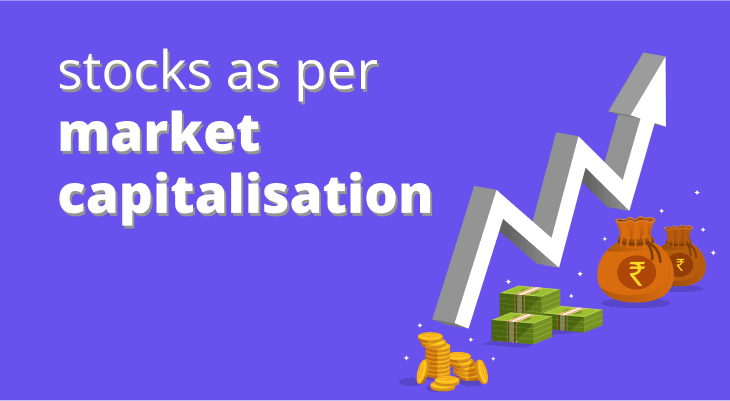
Table of content
- Understanding Market Cap
- The Importance of Market Capitalisation
- Calculating Market Capitalisation
- Market Cap = Share Price × Number of Outstanding Shares
- Significance of Market Cap
- Categories of Companies Based on Market Cap
- Factors Influencing Market Cap
- Considering Market Cap in Investment Decisions
- In Conclusion
What is Market Cap - Basics, Definition, How to Calculate
Understanding what is market cap in stocks is crucial for any investor. Market cap, short for market capitalisation, is a fundamental metric that helps investors assess the size and value of a company in the stock market. It provides insight into a company's financial stability, growth potential, and overall standing in the market. In this comprehensive guide, we'll explore what is market cap in the share market, why it is important, how it is calculated, and how you can use this information to make informed investment decisions.
Understanding Market Cap
So, what is market capitalisation in the stock market? The total value of a company's outstanding shares in the stock market is known as its market capitalisation, or market cap. It is a measure used to determine the company's size and investment appeal. To calculate the market cap of a stock, you multiply the current share price by the total number of outstanding shares. This simple formula offers a quick snapshot of the company's market value.
The Importance of Market Capitalisation
Why is market capitalisation important? Market cap serves as a critical indicator of a company's size, risk, and potential for growth. Larger companies, often referred to as large-cap stocks, are typically more stable and have a lower risk of volatility. In contrast, smaller companies, or small-cap stocks, may offer higher growth potential but come with increased risk. Understanding the market cap helps you evaluate the risks and rewards associated with investing in a particular company.
Calculating Market Capitalisation
The formula for calculating market cap is straightforward:
Market Cap = Share Price × Number of Outstanding Shares
For instance, if Company ABC has 10 Lakh outstanding shares and the current share price is ₹ 100, its market cap would be:
Market Cap = 10,00,000 × 100 = ₹ 10,00,00,000
This means the company's total market value is ₹ 10 Cr. This calculation helps investors understand what is market cap in stocks and provides a basis for comparing companies of different sizes.
Significance of Market Cap
Understanding the importance of market cap in the stock market is essential. It not only indicates a company's size but also its overall stability and growth prospects. It helps investors differentiate between various types of companies and aligns their investment strategies with their risk tolerance and investment goals. Here are a few reasons why the market cap is important in the field of investing and trading.
Investment Strategy
Large-cap companies typically offer stability and steady returns, suitable for conservative investors. Small-cap companies, while riskier, can provide higher growth potential, attracting more aggressive investors.
Risk Assessment
Market cap is a proxy for the risk associated with investing in a company. Larger companies are generally more stable and less prone to market volatility, whereas smaller companies may be more volatile but can offer significant growth opportunities.
Portfolio Diversification
Diversifying investments across companies with different market caps can balance risk and return, helping investors achieve a more stable and resilient portfolio.
Categories of Companies Based on Market Cap
In the Indian context, companies are typically classified based on their market capitalisation into three main types:
Large-Cap Companies
These companies have a market cap of ₹ 20,000 Cr or more. They are well-established, often industry leaders, and considered safer investments.
Mid-Cap Companies
With market caps ranging from ₹ 5,000 crore to ₹ 20,000 crore, mid-cap companies are generally in the growth phase. They offer a balance of stability and growth potential.
Small-Cap Companies
These companies have a market cap of less than ₹ 5,000 crore. Small-cap stocks are often younger companies with high growth potential but come with higher volatility and risk.
Here’s a table that provides a comparative overview of large-cap, mid-cap, and small-cap companies, highlighting their key characteristics and how they differ in terms of market capitalisation, risk, stability, growth potential, and other important parameters.
| Parameter | Large-Cap Companies | Mid-Cap Companies | Small-Cap Companies |
|---|---|---|---|
Market Capitalisation | ₹20,000 Cr and above | ₹5,000 Cr to ₹20,000 Cr | Less than ₹5,000 Cr |
Company Size | Large, well-established companies | Medium-sized companies in a growth phase | Small, often younger companies |
Stability | High stability, less volatile | Moderate stability, moderate volatility | Lower stability, high volatility |
Risk | Lower risk due to established market presence | Moderate risk with growth potential | Higher risk due to market and business uncertainty |
Growth Potential | Lower growth potential, steady growth | Balanced growth potential | Higher growth potential |
Investment Appeal | Suitable for conservative investors seeking stability | Suitable for investors seeking balanced growth and stability | Suitable for aggressive investors seeking high returns |
Liquidity | High liquidity due to large trading volumes | Moderate liquidity | Lower liquidity |
Dividend Yield | Typically higher dividends | Moderate dividends | Lower or no dividends |
Market Perception | Generally seen as safe and reliable | Seen as growth opportunities with moderate risk | Viewed as high potential but speculative |
Response to Market Conditions | More resilient to market downturns | Moderate resilience | Highly sensitive to market fluctuations |
Management Quality | Often have experienced and reputed management | Management quality varies but generally competent | Management may lack extensive experience |
Regulatory Impact | Strong compliance and lower regulatory risk | Moderate compliance | Higher regulatory and operational risks |
Financial Health | Strong balance sheets, steady revenue and profit growth | Reasonably strong financials with growth potential | Often weaker financials but high growth opportunities |
Factors Influencing Market Cap
Several factors can impact a company’s market capitalisation in the stock market:
Stock Price Fluctuations
Any change in a company's stock price directly affects its market cap. Positive news, strong earnings, or strategic acquisitions can drive up the share price, increasing the market cap. Conversely, negative news or poor performance can reduce the stock price and market cap.
Outstanding Shares
The number of outstanding shares can change due to stock buybacks or the issuance of new shares. For instance, if a company issues additional shares to raise capital, the number of outstanding shares increases, affecting the market cap calculation.
Market Sentiment
Investor sentiment plays a significant role in determining a company's stock price and market cap. Factors like economic outlook, geopolitical events, and market trends can influence how investors perceive a company's future prospects.
Company Performance
Fundamental aspects like revenue growth, profit margins, and cash flow significantly impact a company's market cap. Strong financial performance typically leads to higher stock prices and increased market capitalisation.
Industry Trends
Sector-specific trends can affect the market cap. For example, a boom in the technology sector can lead to higher valuations for tech companies, increasing their market cap.
Considering Market Cap in Investment Decisions
When making investment decisions, considering market cap is crucial. Here are some points to keep in mind:
Risk Tolerance
Align your investments with your risk tolerance. Large-cap stocks are generally less risky but offer lower growth potential, making them suitable for conservative investors. Small-cap stocks can provide significant growth but come with higher risk, suiting more aggressive investors.
Diversification
Diversifying your portfolio across different market cap categories can balance risk and reward. A mix of large-cap, mid-cap, and small-cap stocks can provide stability and growth potential, safeguarding against market volatility. This diversification can be achieved via direct stock purchases, or through ETFs of multi-cap, flexicap funds. These funds allocate your funds in a mix of stocks with different market caps with the intention to hedge your risks and benefit from the advantages each type of m-cap has to offer.
Investment Goals
Your investment goals should guide your choices. If you're looking for stable, long-term investments, large-cap stocks may be more appropriate. For higher growth potential, consider mid-cap and small-cap stocks that can offer greater returns but with increased risk.
Market Trends
Keep an eye on market trends and economic indicators. Certain sectors may perform better at different times, affecting the market caps of companies within those sectors. For example, during a tech boom, tech stocks might see significant appreciation.
Valuation Metrics
Combine market cap analysis with other valuation metrics like P/E ratio, P/B ratio, and dividend yield to get a comprehensive view of a company's value and potential. This holistic approach can help you make more informed investment decisions.
In Conclusion
Understanding what the market cap is, in stocks, is fundamental to making informed investment decisions. Market capitalisation offers insights into a company's size, stability, and growth potential. By calculating market cap and considering it alongside other financial metrics, you can better assess the risk and reward associated with different investment opportunities. Whether you're a conservative investor seeking stability or a growth-oriented investor willing to take on more risk, the market cap is a valuable tool in your investment arsenal.
FAQ
What is the market cap in stocks?
Market cap, or market capitalisation, is the combined value of a company's outstanding shares in the stock market. It is derived by multiplying the total number of outstanding shares of a company by its prevalent share market price. This metric helps you understand the size and value of a company in the stock market.
What does market cap tell you?
Market cap provides a quick snapshot of a company's overall value as perceived by the stock market. It indicates the size and scale of the company, helping investors gauge its stability, risk profile, and growth potential. Large-cap companies are typically more stable and less volatile, mid-cap companies offer a mix of stability and growth, and small-cap companies are often more volatile but have higher growth potential. Market cap can also help you compare companies within the same industry or across different sectors, aiding in the diversification of their investment portfolios. It helps you evaluate the risk and reward associated with investing in a particular company, making it easier to compare companies of different sizes.
How is market cap calculated?
Market cap is calculated using the formula:
Market Cap = Share Price x Number of Outstanding Shares
For example, if a company has 10 Lakh shares priced at ₹ 100 each, its market cap is ₹ 10 Cr.
What are large-cap companies?
Large-cap companies are those with a market capitalisation of ₹ 20,000 crore or more. These companies are well-established, often leaders in their industries, and considered stable investments.
What are mid-cap companies?
Mid-cap companies have a market capitalisation between ₹5,000 crore and ₹20,000 crore. These companies are usually in a growth phase and offer a balance of stability and growth potential.
What are small-cap companies?
Small-cap companies have a market capitalisation of less than ₹ 5,000 crore. They are often younger companies with high growth potential but come with higher volatility and risk. Many emerging startups and niche market players fall into this category.
How does market sentiment affect market cap?
Market sentiment, which includes investor perceptions and attitudes, can significantly impact a company's stock price and, consequently, its market cap. Positive news and strong earnings reports can boost investor confidence, increasing the share price and market cap, while negative news can have the opposite effect.
Can a company's market cap change?
Yes, a company's market cap can change due to fluctuations in its share price or changes in the number of outstanding shares. Factors such as stock buybacks, issuing new shares, and overall market conditions can impact the market cap.
Is market cap a good indicator?
Market cap is a useful indicator for assessing a company's size and market value, but it should not be the sole metric used for investment decisions. While it provides insights into a company's relative size and potential risk, it does not account for other important factors such as profitability, revenue growth, debt levels, and management quality. Therefore, you should use market cap in conjunction with other financial metrics and fundamental analysis to make well-informed investment decisions.
How much market cap is good for a stock?
The ideal market cap for a stock depends on your investment goals, risk tolerance, and investment strategy. Large-cap stocks are generally considered safe investments due to their stability and established market presence. They are suitable for conservative investors seeking steady returns. Mid-cap stocks offer a balance between stability and growth potential, making them attractive for investors looking for moderate risk and growth. Small-cap stocks can provide significant growth opportunities but come with higher risk and volatility, making them suitable for aggressive investors willing to take on more risk for potentially higher returns.


